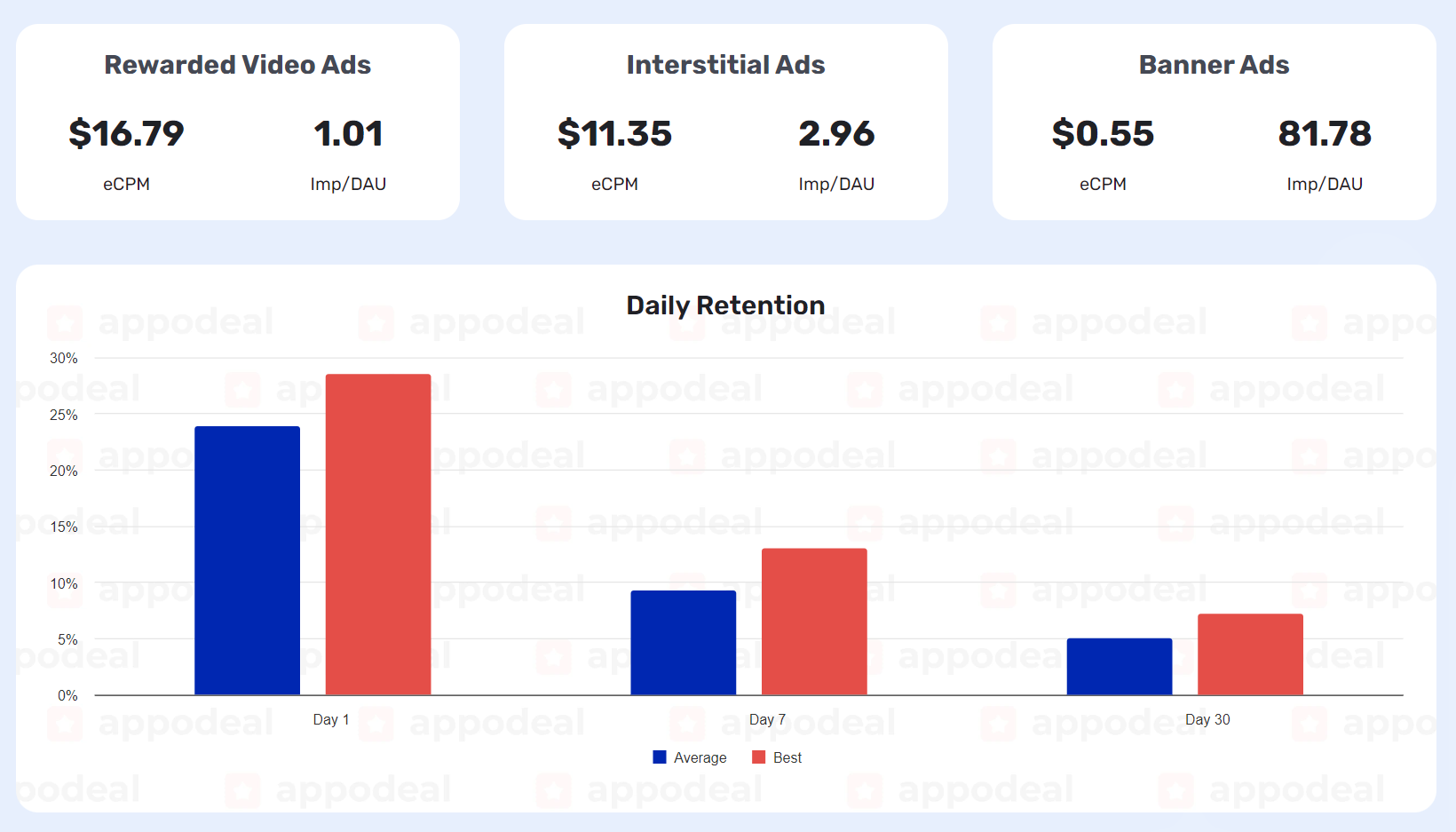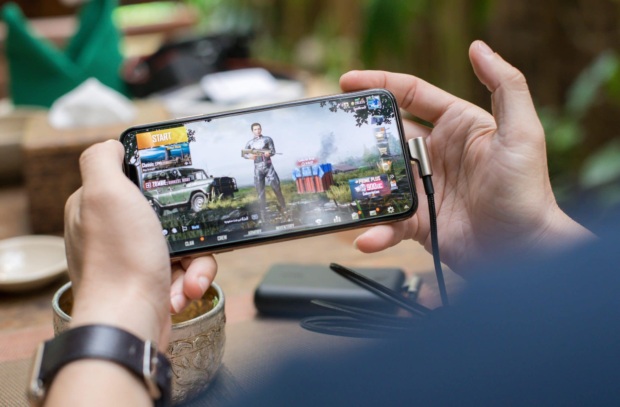Updated on January 21st, 2025.
We’re thrilled to announce the release of Appodeal Benchmarks, a powerful, free-to-use tool for anyone in the mobile gaming and ad tech industry!
As with the old eCPM Report, we will update the data on our new tool, Appodeal Benchmarks, every quarter. But this time, we will not just give you eCPMs but also retention data, ad impressions, and much more data, based on millions of ad impressions worldwide from 80+ Ad Networks.
With Appodeal Benchmarks, we’re giving mobile app developers, publishers, and marketers the tools they need to fully understand their monetization potential across multiple dimensions — on-demand and free.
Optimize your Ad Monetization Strategy, find new audiences, and learn new ways to increase your revenues.
Try out Appodeal Benchmarks today and take the guesswork out of monetization!
Summary:
eCPM Reports on Demand!
While many companies are moving towards more closed-off ecosystems, we at Appodeal take the opposite approach. Transparency and data accessibility are at the core of our mission—to help app creators scale and grow their businesses with clear, actionable insights.
This marks a significant step forward in providing transparency and accessibility in an industry that often feels like a black box.
With Appodeal Benchmarks, you can dive deep into the mobile ad industry like never before. You’ll have access to key monetization and retention metrics—such as eCPMs, Impressions per User, and Daily Retention Rates—all broken down by app category, country, platform, and more, giving you a comprehensive understanding of your app’s performance in a matter of clicks.
How to use Appodeal Benchmarks?
It’s simple. Our tool features five filters:
- App Category: Choose from the categories available on major app stores.
- Mobile Platform: Select iOS or Android.
- Country: Filter data by specific countries where we have robust data sets.
- Period: Pick the month for which you want to view data.
- App Size: Filter by app size to compare with apps that match your user base—whether your app has a few million installs or hundreds of millions.
Once these are set, you’ll receive detailed and highly accurate metrics tailored to your needs.

Right now, Appodeal Benchmarks offers insights into the three most important metrics we’ve identified:
- eCPMs (Effective Cost per Mille): The revenue generated per 1,000 ad impressions.
- Impressions per User: The number of ad impressions served per user in a given period.
- Daily Retention Rates: How well your app retains users over time.
We’ve chosen these metrics based on their relevance to monetization and retention strategies, but we’re just getting started.

More metrics will be added soon, and we’d love to hear your suggestions!
Feel free to contact me on LinkedIn if there’s a specific metric you’d like to see in the Appodeal Benchmarks!
Why Appodeal Benchmarks? A Natural Evolution
When I joined Appodeal in early 2020, I launched the Mobile eCPM Report, which provided quarterly insights into eCPMs across the top 3 mobile ad formats: banners, interstitials, and rewarded videos.
What started with just five countries quickly grew to nearly 20, offering developers key information on monetization performance worldwide.
Building on that foundation, we also released the Mobile Performance Index Report annually, which added new dimensions like ARPU (Average Revenue per User), impressions, and retention data. These reports were well-received, but we knew we could take it further.
Appodeal Benchmarks is a natural evolution of all those reports. A tool that goes beyond eCPMs and brings more monetization metrics, such as data impressions and even retention metrics! We have also expanded the list of countries from 20 to over 120!
This was a well-deserved update in an industry that is ever-changing and forever challenging.
Finally, get instant access to top-quality data without digging through lengthy reports!
What’s Next for Appodeal Benchmarks?
We’re committed to keeping Appodeal Benchmarks as fresh and relevant as possible. We're working to update the data once every quarter, just like our original Mobile eCPM Reports. We’re also working on several new features, including:
- Regional & Tier Filters: We’re expanding country filters to include regions like West Europe, East Europe, EMEA, Asia, etc., as well as classifications by Tier-1, Tier-2, and Tier-3 markets.
- Quarterly Periods: Besides monthly metrics, you’ll soon be able to view data over broader periods.
- Trend Charts: Similar to the Mobile eCPM Report, we want to display the evolution of key metrics over time with charts showing month-by-month data.
About the Data Source
It’s one thing to talk about transparency, but with Appodeal Benchmarks, we’re showing it. The data in this tool is drawn from billions of anonymized ad impressions we serve across our network.
Unlike other benchmarking tools in the industry, the Appodeal Benchmarks breaks down revenue metrics by specific ad formats, offering the most accurate picture possible for each app category and platform.
The Appodeal Benchmarks represent the average eCPMs from billions of ad impressions served during the analyzed period for each country worldwide, where we have significant impression data.
Our algorithm evaluates each ad bid in real time, serving the highest bidder to ensure your app's best possible ad revenue. While many tools offer broad industry averages, we provide detailed, format-specific metrics—something almost no one else in the gaming industry is doing.
We hope mobile app publishers and developers will find the Appodeal Benchmarks useful for their app's ad revenue and for gaining a fuller understanding of earning potential worldwide as their app grows.
About the Old Mobile eCPM Report
tldr; The Old Mobile eCPM Report has been moved to Appodeal Academy in a course format for better accessibility.
For the last five years, I've been building the eCPM Report, a trusted resource for mobile app creators and publishers, delivering critical insights into ad performance trends. It’s guided developers worldwide to make smarter monetization decisions and unlock their app’s revenue potential.
Now, in our mission to provide an even more comprehensive and tailored learning experience, I'm excited to announce that all eCPM Report insights have been moved exclusively to the Appodeal Academy.
Why the Change?
This move allows us to offer more than just static insights. By integrating the eCPM Report data into the Academy, we can provide:
- Interactive Learning: Dive into detailed modules segmented by year, quarter, and ad format to understand eCPM trends in greater depth.
- Actionable Strategies: Each module and lesson includes takeaways designed to help you immediately implement growth-boosting strategies for your apps.
- Better Accessibility: Instead of searching through blog archives, you’ll find the insights structured into an easy-to-navigate curriculum within the Academy.
- Community Support: The Academy is more than just a resource hub—it’s a community of like-minded app creators and industry professionals who are passionate about mobile growth.
How to Access the eCPM Insights
To explore the latest eCPM trends and actionable advice for optimizing your monetization strategies, simply visit the Appodeal Academy. Signing up is quick, and you’ll gain access to exclusive free courses, apart from the eCPM Report Insights, including the full breakdown of global eCPM performance for Rewarded Videos, Interstitials, and Banners.
By consolidating all eCPM insights into the Academy, we aim to empower app creators like never before—offering not just data but the knowledge to interpret and act on it for long-term growth.
Head over to the Academy and unlock the full potential of your app’s monetization strategy today!
When game developers venture into influencer marketing to promote their mobile games, it's easy to fall into some common pitfalls.
TIP: Check our previous blog post talking about “Tips for Game Devs working with Influencers”.
Influencer marketing has seen a significant rise in recent years. Influencers offer a reliable and impactful way to acquire users, often delivering thousands—if not millions—of impressions. These impressions come from highly engaged users who are more likely to install your game.
Influencers build trust with their audience, making their endorsements feel like genuine recommendations from a friend.
If you're seeking new ways to acquire users for your mobile apps and games while maintaining an active presence on social media, keep reading for actionable insights!
Summary:
- Why transparency matters when working with influencers
- Finding the perfect balance between clear guidance & creative freedom for your influencer campaigns
- Selecting the perfect influencer for your matching audience
- Digging into your influencer's metrics before partnering
- Tracking & monitoring your campaigns
- BONUS! Tips to getting started with influencer marketing
#1 - Be transparent with your Goals
Transparency is highly valued by influencers.
When influencers promote a product, they take a risk. If the product doesn’t align with their audience’s expectations, they could lose the trust and loyalty they’ve built over years of hard work. This makes them cautious about collaborations.
If the partnership goes poorly, influencers may become hesitant to work with you in the future. Therefore, it’s essential to approach these partnerships with sensitivity and an understanding of their concerns.
An influencer’s top priority is maintaining the loyalty of their audience. Betraying this trust can backfire not only on the influencer but also on your brand. Clear communication and mutual respect are crucial for a successful collaboration.
#2 - Give them some Creative Freedom
Influencers excel at crafting compelling stories that resonate with their audiences. If their narrative aligns with your app’s message, it creates a natural connection with their followers.
To achieve this, select influencers whose style and tone complement the image you want to project. This way, they don’t have to significantly alter their approach, and their audience is already primed to engage with your content.
Providing creative freedom allows influencers to work within their strengths, making their endorsements feel more authentic.

Avoid micromanaging. Over the years, many influencers have invested in improving their creative skills through courses and programs, making them more adept at crafting engaging content. Trust their expertise to deliver results.
Strike a balance between offering clear guidance and remaining open to their ideas and requests.
Influencers understand their audience better than anyone and will naturally find the best ways to present your app or game.
Collaborating with Influencers: Tips for Success
Treat Them as Creative Partners: Don’t view influencers merely as a traffic source. Think of them as creative consultants who excel at user engagement. They understand what resonates with their audience and can showcase your app or game in innovative and effective ways.
Communicate Your Goals Clearly: Ensure influencers fully understand the benefits and unique selling points of your app or game. This allows them to craft a narrative that highlights these features authentically.
Invest in Long-Term Relationships: A lasting partnership fosters trust and ensures better outcomes over time.
By fostering collaboration based on trust, creativity, and mutual respect, you can maximize the potential of your influencer marketing campaigns, connecting with audiences in meaningful ways and driving measurable results.
#3 - Find influencers with matching Audiences for your mobile games
As mentioned earlier, it’s essential to ensure that the influencer’s audience aligns with your target audience.
To achieve this, you first need to define your audience. Start by imagining two or three "ideal players" for your app or game. Consider their habits, hobbies, interests, and daily routines. You can use various online resources to create detailed “user personas” to represent your audience segments.

This preparation will help you save money and avoid costly mistakes, such as signing expensive contracts with influencers who may not resonate with your target audience.
Understanding your audience is a critical step that should precede reaching out to influencers you’ve identified as potential partners. Once you have clarity about your top audiences and are building a sales pitch to engage the influencer, make sure to assess:
- The Influencer’s Audience: Look into follower count, content quality, and engagement ratios (e.g., views or interactions per post).
- The Influencer’s Main Platform: Most influencers are active on platforms like YouTube, Instagram, or TikTok, but you might also discover opportunities in niche forums or smaller communities.
Keep in mind that engagement rates can vary significantly depending on the platform, so factor that into your evaluation.
#4 - Checking the Influencer’s Engagement Metrics
Assessing the engagement and receptiveness of the influencer’s audience is crucial before formalizing a partnership. There are numerous metrics to consider:
There are plenty of metrics that you can take into consideration:
- Number of Subscribers
- The Average Views (per each publication)
- Engagement Ratio: The percentage of likes, comments, and shares relative to views
- Impression Trends Over Time: Analyze how views or interactions evolve for individual posts.
- Audience Reactions to Sponsored Content: Study how the influencer’s audience has responded to promotional content in recent months.

While the number of subscribers and average views may serve as quick scouting tools, they shouldn't be the sole deciding factors. Delve deeper into engagement metrics, and don’t overlook quality indicators like comment sentiment.
These details provide valuable insights to help you make informed decisions about allocating your marketing budget.
#5 - Track & Monitor your Results
As emphasized in our previous article, tracking and monitoring your influencer campaigns is one of the most common yet critical aspects that game developers often overlook.
Real-time tracking of your campaign’s performance across all channels might seem time-intensive, but the insights gained are invaluable. Properly setting up a monitoring system allows you to analyze how newly acquired users interact with your app or game.
Here’s how tracking can benefit your influencer campaigns:
- Campaign Optimization: Identify and address issues users may encounter in real-time.
- Content Insights: Determine which messages, tones, or styles resonate most with your audience.
- Audience Sentiment: Monitor the audience's reactions and refine your approach accordingly.
- Feature Improvements: Enhance in-game features or services based on audience feedback.
- Performance Evaluation: Track which influencers meet or exceed campaign goals.
- Future Negotiations: Use data to renegotiate deals or discontinue collaborations that fail to generate a return on investment (ROI).
Consistent monitoring helps maximize the effectiveness of your campaigns while providing a solid foundation for future decision-making.
#6 (Bonus!) - Start your Influencer Campaign!
Now it’s time to put all these strategies into action. Combine the insights from this article with those from our previous post to develop a robust influencer marketing campaign.
Influencers can be a powerful asset, enabling you to reach new audiences and generate excitement around your app. By partnering with the right influencers, you’ll discover that they’re a valuable resource for driving installs, creating buzz, and diversifying beyond traditional paid user acquisition campaigns.
Start applying these tips to your influencer marketing strategies, build a strong foundation, and watch your mobile apps and games grow as you engage with untapped audiences.

Game developers are constantly searching for new ways to attract users to their apps. With the rise of various social media channels over the last few years, influencers have emerged as a valuable source of impressions and engagement.
If you're struggling to increase installs or enhance brand exposure for your mobile game or app while your paid campaigns are limited to Google Ads, this article will introduce you to alternative possibilities you may not have considered.
Keep reading to learn the basics of community influencers and how game developers can effectively collaborate with them.
Summary of this article:
- Influencers: Professionals or Amateurs?
- Micro vs. Macro Influencers
- What can influencers do for your Mobile Game?
- Brand Awareness vs. Performance
- Building partnerships with Influencers
- Starting your Influencer Campaign
Influencers: Professionals or Amateurs?
When game developers hear the term "influencer," they often picture a trendy millennial posing for selfies at a scenic location, decked out in high-end cosmetics, designer outfits, and the latest smartphone, all while farming views and likes on social media.
However, this stereotype is far from reality. Most influencers are not celebrities—at least not in the traditional "Hollywood" sense. Often, they lack formal marketing expertise.
Influencers typically begin their journey by creating a channel as enthusiastic fans of a brand, showcasing their extensive product knowledge, or actively participating in a community. Through these efforts, they gain recognition and evolve into powerful advocates for the brands and products they love.
Some influencers are even game developers themselves, building their following by sharing their passions and establishing genuine connections.
We often overlook that many influencers have lucrative full-time careers in their respective industries. With the rise of cryptocurrencies, for instance, some niche influencers have amassed small but highly profitable followings of around 1,000 dedicated fans.
Micro vs. Macro Influencers
Influencers can be categorized based on the size of their audience: Nano, Micro, Macro, and Mega influencers.

Mega influencers
Mega influencers are global celebrities and public figures with over one million followers. Their influence extends beyond social media platforms like YouTube or TikTok. However, their massive audience makes them challenging and expensive to work with, especially for indie developers and mid-size studios.
Macro Influencers
Macro influencers have between 100,000 to 1 million followers. They are an excellent choice if you have a larger budget and want to target a specific niche or geographic area. Unlike mega influencers, macro influencers typically build their followings from scratch, fostering stronger connections with their audience, who trust their opinions.
Micro-influencers
Micro influencers have fewer than 100,000 followers. Although their audiences are smaller, they are more loyal and engaged. Partnering with micro influencers is often more affordable, making it an ideal option for startups in the gaming industry. Collaborating with multiple micro influencers allows you to reach several niches and maximize your campaign’s value.
What can influencers do for your Mobile Game?
The primary strength of influencers lies in their ability to drive engagement. Collaborating with influencers can help establish organic relationships with their followers. Here are some strategies:
Some strategies to follow come from:
- replying to comments,
- participating in discussions,
- or sharing user-generated content.
When an influencer starts a conversation about your brand or product, it feels less like an advertisement and more like a recommendation from a trusted friend.
This dynamic fosters authentic engagement, leading people to download your app based on the influencer’s endorsement. As a bonus, your app might climb the charts due to the influx of organic installs generated by the campaign.

Furthermore, a significant advantage for mobile apps and games is that when an influencer promotes your game, it often leads to increased app installations, propelling your app higher in the top charts.
Similar to a burst campaign, this strategy leverages the momentum of new paid installs to drive additional organic installs. However, to achieve this level of impact, it’s essential to collaborate with an influencer who has the appropriate reach or to implement a well-coordinated campaign involving multiple smaller influencers.
Brand Awareness vs. Performance
People are more likely to take action when they feel a connection with someone they trust. When trusted influencers or celebrities engage with your app, their audience is more inclined to try it or at least explore it in the app stores.
This is why influencers are often credited with driving high-quality traffic to your App Store page and social media channels.
Even if users don’t immediately download your app based on an influencer’s recommendation, they will still become aware of your brand. The next time they encounter your app—whether through paid ads or organic reach—they will be more likely to give it a try.
Additionally, by channeling an influencer’s audience to your page, you can build retargeting campaigns to engage users who might have been otherwise out of reach.
When influencers align with your app's niche and core target audience, collaborating with them can make it significantly easier to create performance-driven campaigns that convert their followers into active players of your app or game.
Building partnerships with Influencers
The simplest way to begin collaborating with an influencer is by agreeing on a set price for each sponsored publication.
However, as a game developer with a robust analytics system integrated into your game, you have various options to negotiate more advantageous deals.
Consider compensating influencers based on performance goals and objectives. Just as you track installs or in-app events in your performance campaigns, you can set up milestones and track each attributed user brought in by the influencer.

Since influencers are essentially promoting your app on their channels, you can incentivize them with bonuses tied to their performance.
Building on this, you could create a series of badges or mentions on your brand’s social media profiles or website. For instance, you might add a “collaborators” page on your landing site to showcase these partnerships.
If the influencer genuinely enjoys your app or game, you can offer additional perks like free premium services, in-game currency, or exclusive skins for them to display.
For those willing to go the extra mile, you could even integrate the influencer directly into your app. For example, create a non-player character (NPC) or a custom skin inspired by their likeness or logo.
Ultimately, the extent of this collaboration will depend on your creative flexibility and the influencer’s willingness to take on a more public role within your app, game, or brand.
Monitor and adjust as needed
Once you’ve finalized a deal with an influencer, resist the urge to immediately launch the campaign.
First, ensure that your analytics system is correctly configured to track the performance of all the influencers you’re collaborating with.
Whether your agreement is a straightforward "price per publication" deal or a more intricate one tied to specific goals, tracking influencer performance is critical.
Monitoring these results will also help you gain deeper insights into the quality of users influenced by the campaign. Key questions to consider include:
- Are they spending on in-app purchases (IAPs)?
- Are they engaging with in-app ads (IAAs)?
- Are they dropping out (churning) before or after the tutorial?
- Are they being properly tracked by your CRM, so you can create effective retargeting campaigns later?
Given the investment in this campaign, it’s essential to make it count. A robust analytics system will help you identify influencers who may not be meeting their targets, enabling you to renegotiate or optimize current and future deals as needed.
Start your Influencer Campaign!
Over the past year, the mobile app and gaming ecosystem has undergone significant changes. While app downloads continue to flourish, marketing professionals must adapt to the evolving ad-tech landscape. Game developers, in particular, face challenges in understanding how users interact with their apps.
In this dynamic environment, influencer marketing stands out as an excellent and reliable method for acquiring users who might otherwise be difficult to reach.
With the concepts and strategies outlined in this post, you should now feel prepared to start collaborating with the right influencers. They can be a powerful asset in expanding your audience and implementing tailored monetization strategies.
Begin by identifying influencers who align with your mobile apps, craft a solid strategy around their strengths, and unlock new opportunities to connect with broader audiences.
